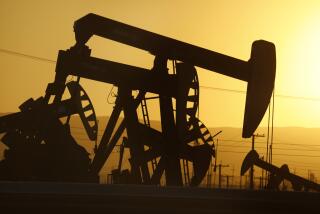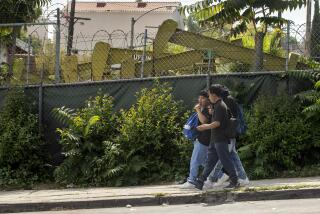Blown-out BP well is declared dead
Reporting from Atlanta — Rob Canty heard the news on TV on Sunday morning at his home in St. Tammany Parish, La.: The wild oil well that changed his life — and the lives of thousands of others along the Gulf Coast — was sealed up, safely and permanently, thanks to an injection of cement 18,000 feet below the ocean’s surface.
After nearly five months of heartache, misery and worry, the BP well in the Gulf of Mexico was dead.
The news was “real good,” said Canty, a 31-year-old shrimper, but it wasn’t likely to change his life immediately. His shrimp boat is still contracted out indefinitely to BP, he said, and for the time being, he expects to remain among the 25,200 people hired to finish cleaning up the largest offshore oil spill in U.S. history.
“We’re ready to try to go back fishing, but I don’t think that’s going to happen anytime soon,” Canty said. “We still got oil out there.”
Sunday’s announcement of the successful “bottom kill” of the BP well was met with relief, but only muted fanfare, as nearly all the players in the drama — including President Obama, outgoing BP Chief Executive Tony Hayward and a number of Gulf Coast residents — emphasized that the story was far from over, and that much more work remained to be done.
“Today, we achieved an important milestone in our response to the BP oil spill,” Obama said in a statement, adding that members of his administration “remain committed to doing everything possible to make sure the Gulf Coast recovers fully from this disaster.”
“This road will not be easy,” he said, “but we will continue to work closely with the people of the gulf to rebuild their livelihoods and restore the environment that supports them.”
Hayward — whose gaffes during the spill resulted in his ouster, effective Oct. 1 — declared that the well “no longer presents a threat to the Gulf of Mexico,” adding that BP’s commitment to repair the damage “remains unchanged.”
The final plugging of the well was a somewhat underwhelming denouement to one of the great engineering challenges in modern times. After a number of missteps, BP was able to seal the well in mid-July with a temporary custom cap.
Once the oil had stopped flowing, experts embarked on a slow, careful, multistep process to ensure that it would be shut in for good: In early August, the seal was improved with a shot of drilling mud and cement from the top. Later, crews swapped out the old blowout preventer — the safety device that failed during the April 20 blowout of the Deepwater Horizon oil rig, killing 11 workers — with a newer, stronger cap.
Throughout the process, Thad Allen, the federal spill response chief, asserted that the well could be considered dead only when the outer ring of the well, called the annulus, was also plugged with cement from deep underground.
After testing to ensure that they would do no harm, crews on Thursday drilled into the annulus nearly 18,000 feet below the ocean’s surface, then began filling it with cement to ensure that oil would never again flow from the reservoir below.
Pressure tests were conducted late Saturday night that showed the cement job had been a success. On Sunday morning, Allen declared the well “effectively dead.”
“From the beginning, this response has been driven by the best science and engineering available,” Allen said in a statement. “We insisted that BP develop robust redundancy measures to ensure that each step was part of a deliberate plan, driven by science, minimizing risk to ensure we did not inflict additional harm in our efforts to kill the well.”
That was about as happy as anyone allowed themselves to be, at least in public. Even on the drilling rig some 50 miles off the Louisiana shore, the Associated Press reported that crews wouldn’t celebrate much. They’d treat themselves to prime rib on news of a job well done, but Rich Robson, the offshore installation manager, said the mood was bittersweet.
“To a lot of people, the water out here is a cemetery,” he said.
With the cement job completed, oversight of the well will shift from the National Incident Command, which was set up to deal with spill-related issues, to the Bureau of Ocean Energy Management, Regulation and Enforcement, which regulates offshore oil drilling.
BP plans to complete the abandonment of the well, removing portions of casing and further securing the well. The company will also begin dismantling and recovering the various equipment used in the effort to plug the well that has gathered around the wellsite over the months.
The more complicated work, however, is the ongoing effort to find and clean up the remaining oil, and measure and mitigate its effects on the environment.
Before it was capped, the well spewed 205.8 million gallons of oil. Much of it remains at sea.
According to the federal government, about 110 miles of shoreline are experiencing “moderate to heavy oil impacts,” most of it in coastal Louisiana.
Of great concern to scientists is the huge amount of oil — about a quarter of the total — in droplet form that is floating in vast clouds in the deep water. The long-term effect of these clouds, and the ability of bacteria to break them down naturally, is not clear.
Aaron Viles, campaign director of the Gulf Restoration Network, an environmental nonprofit in New Orleans, said the sealing of the well gave him a sense of “trepidation.”
“Because I know that as that news comes out — that it’s the ‘final seal of the well’ — it’s kind of the final real attention this issue’s going to get, in the world’s eyes at least.
“I do think that, while we’re likely at the end of the big telegenic story, the more challenging piece remains,” he added. “Which is quantifying the impact and responding in the most effective way to ensure these resources can recover.”
richard.fausset@latimes.com
More to Read
Sign up for Essential California
The most important California stories and recommendations in your inbox every morning.
You may occasionally receive promotional content from the Los Angeles Times.










